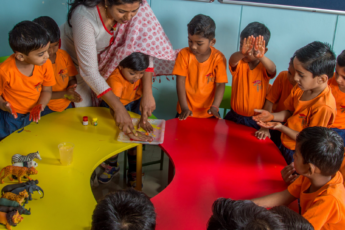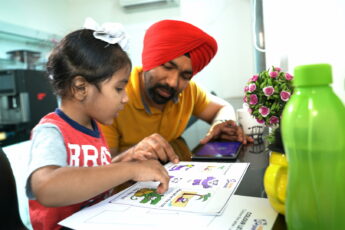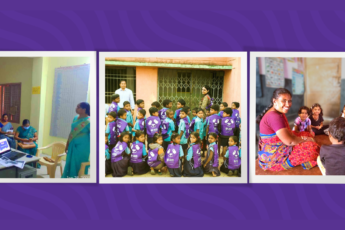The Need to Implement Blended Learning in Preschool

With the vast proliferation of digital tools and the growth of online learning platforms, blended learning has gained traction as the go-to instructional strategy for teachers and students in early classrooms. Today’s digital-age learners have grown up amidst technology that would have been almost unimaginable a decade ago, which is why they have found it much easier to transition to a blended learning class as opposed to a classroom in which they do not use any form of technology.
A study has suggested that when blended with face-to-face instruction, online learning can help preschoolers develop a deeper understanding of course material, promote creativity and collaboration, and result in a greater sense of student engagement.
Blended Learning: A Modern Imperative
Although most early childhood professionals would agree that blended learning is the ideal teaching method for pre-K, it can also be one of the hardest to implement. Finding ways to foster creativity in your classroom will help you build a thriving blended learning environment that will be better than ever before.
Connecting with your students is a vital part of the blended learning framework. By getting to know each student one-on-one, you better understand their personal needs and interests. When you know your students, you can then decide how to bring that learning into the classroom. Creating a dynamic classroom where individual learners are challenged according to their strengths and weaknesses is the foundation for blended learning. As preschool teachers, you can introduce a few concepts of blended learning throughout the year. It’s crucial to constantly break new material down into smaller bits before teaching 4-year-olds who learn new material faster.
Blended learning integrates various learning styles and strategies—such as digital learning, independent study, and project-based instruction. The use of technology enables teachers to assess each student’s skill level and align lessons around their specific interests, needs, and abilities. A teacher can use these methods to determine how well a student is progressing throughout the course, then offer further lessons that target differing needs for each student.
One of the most popular blended learning models, the station rotation model, requires teachers to split their classes into smaller subgroups. Students are given a schedule that prioritizes learning activities, including an online or digital component, which are rotated through on a timed schedule. Another way to implement blended learning in a preschool setting is by a flipped classroom. It is educational training that allows students to go home and review the coursework online. Teachers then meet with individual students to further develop an understanding of the course content. The class time is spent applying material by working through simulations or other hands-on activities. Research has shown that using these modes provide better opportunities for individual instruction and more frequent feedback to the student.
The Impact of Student Engagement in Early Childhood Classrooms
With the pressure to meet academic standards implemented in early grades, such as preschool, teachers need to help their students focus on the tasks at hand. One strategy to help promote engagement is blended learning. This type of learning combines face-to-face instruction with digital tools to provide personalization and differentiated instruction based on student needs, encourage technology integration, and motivate students toward desired ends. It combines the individualized attention of traditional brick-and-mortar classrooms with the adaptability and flexibility of digital tools to facilitate lively, engaging learning sessions. Through blended learning, teachers will meet each student wherever they might be, students will be able to learn what they need outside the classroom setting, and students will have more opportunities to collaborate with their peers.
Screen time in the form of technology and interactive media has provided opportunities for our students to grow in ways we could never have imagined. This, however, raises concerns due to the ever-growing concern of overuse and misuse. This has brought on the need to switch up teaching style in an effort to understand how to use blended learning effectively and what dangers might arise from its use.
However, when students and teachers embrace technology in the classroom, everyone wins. Students gain access to a more diverse curriculum, and teachers are able to reach more students. With a comprehensive learning platform, teachers can help students bridge educational gaps and set individualized learning goals. Blended learning provides educators with the tools they need to engage students so they are empowered to create an inclusive learning experience, and through it, begin a hopefully lifelong love for learning that stands one in good stead.
Square Panda encourages the use of blended learning in classrooms and beyond, giving students access to the personalized learning they need to succeed. Children learn at their own pace using interactive programs, giving them the self-confidence to realize their full potential.
To know more, visit ecce.squarepanda.in




Leave a Comment